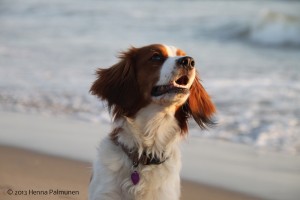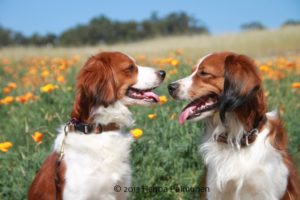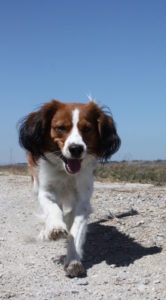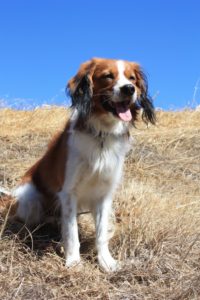Origin, history and background of the Kooikerhondje Breed
Extract from the English version of "The Big Kooikerhondje Book" by Monika Dassinger

You might think you have met this breed before when you come across a Kooikerhondje, with its strikingly colored coat and small but compact body. This breed is relatively unknown and can get easily confused with mixed breed dogs originating from southern areas of Europe. We really need to go back to Spain if we want to follow the history of the Kooikerhondje all the way to the beginning.
Most likely, Spaniards brought these colored bird-dogs to the Netherlands during the Spanish leadership in the 15th century, hence the name Spaniels.
One can often find the small, colored spaniel type dogs in old paintings in big museums. For example Jan Steen (1626-1679), a well-known Dutch painter, named one of his famous paintings “The happy house companion,” and Hendrik Martensz-Sorgh (1611-1670) created the “Lutist.” There is also a dog in the painting from J.A. Kruseman which shows Louise, princess of Oranien Graefin de Caligny, with her son Frederik Prince von Oranien painted in 1847, and you can also see a dog that has a lot in common with the Kooikerhondje of today.
Art fans can find more of those beautiful paintings in the museums in Amsterdam, Utrecht, Rotterdam, Germany, and Paris or in the Oranien Nassau Museum in Dillenburg.
People in the Netherlands continue to tell stories of their forefather, Prince Wilhelm von Oranien (1533-1584), also called Wilhelm the Quiet, who had a small-checkered Spaniel on his side. This dog was apparently an active player in history:
Prince Delft always had a small dog with him at his his temporary residence from which he fought the battle in 1572 against the Spanish captivation of the Netherlands,. The prince had the opportunity to flee from a nighttime murder, thanks to the alertness of his little dog that started licking his master’s face to warn him of the invaders,. This type of Spaniel started to carry the name “Prince Hondje” or “Wilhelm the Quiet dog.” Prince Wilhelm von Oranien nevertheless ended up being assassinated at a later time (1584). The legend says the dog died soon thereafter due to the sorrow of his master’s loss.
A mausoleum was built to honor the prince in the new church in Delft. There are two sculptures made from white marble. One shows the sleeping prince on his bed. The other one shows the dog lying at his feet. Unfortunately, it is difficult to trace this touching story backwards. But, it is certain that the Prince von Oranien had one of these Kooiker-type dogs towards the end of his life at his side.
The history of the Kooikerhondje stops temporarily at this point in time. During the Second World War, the name of the “Prinsenhondje” or “Wilhelm the Quiet dog” was changed to Kooikerhondje due to its type of work in the duck kooi.
Finally, the history of the Kooikerhondje continues when, in 1939, the Baronesse van Hardenbroek van Ammerstol (1901-1986) had the idea and the committment to recover the almost extinct Kooikerhondje.
The beginning of breeding
The Baronesse van Hardenbroek van Ammerstol had given a clipping from the coat and a description of the Kooikerhondje to a passing-by itinerant trader so that he could look out for similar dogs. She bred her first litter, or “nest,” as it is called in the Netherlands, in 1939, with her Kooiker bitch “Tommie” found in Friesland, and with “Bennie” a male also originally from Friesland. Although “Tommie” is usually a male name, she turned out to be a very feminine and beautiful bitch with shining red-orange markings. The stud male “Bennie” had lighter brown markings and a brown nose. The second “litter,” as it is called in English, or “Wurf,” in German, was born in 1942 with “Tommie” and “Bobbie.” This male was beautiful, very smart and not too big, with a black nose and a stable personality. “Tommie” is considered the founding bitch, and “Bobbie” the founding dog for all Kooikerhondjes. They continued to be used in subsequent breedings.
Baronesse van Hardenbroek van Ammerstol had to return “Tommie,” unfortunately, to the owner since she was not the Baroness's own  bitch. Shortly after returning to her owner, “Tommie” passed away.
bitch. Shortly after returning to her owner, “Tommie” passed away.
More and more passionate breeders joined Baronesse van Hardenbroek van Ammerstol. Kooikerhondje litters were born in regular intervals. Other breeds like the Cocker Spaniel and the Keeshond were mixed in as well because the population was small and the bloodlines too narrow. It was, and is still a challenge to breed Kooikerhondjes.
In 1946, the first Kooikerhondjes were added in a temporary registry within the Raad van Beheer (national kennel club within the Netherlands, like the German “Verband fuer das Deutsche Hundewesen e.V.”, VDH or the American Kennel Club, AKC) without numbers. “Nico,” a Kooiker male, received the temporary registeration number VR 1 from the registry in July, 1954.
The Baronesse and her co-breeders aimed for official recognition of the breed. The first Kooikerhondje shows were organized under the umbrella of the Raad van Beheer. In 1958, 1959, and 1961, and on June 18, 1966, the breed was provisionally registered in the Netherlands. The Baronesse was getting close to her goal. At that point, a tenative breed standard was created. More shows had to follow in the Netherlands between 1967 and 1970 before the official recognition of the “Kooikerhondje,” could occur.
All Kooikerhondjes bred from the Baronesse carried the kennel name “van Walhalla.” Her last litter was registered on April 11, 1965. The Baronesse continued to have a fulfilled life on her estate and passed away in 1986. Her tomb can be found in a town called Nuenen near Eindhoven.
The Raad van Beheer decided June 12, 1971 to implement a transition time since the breed was still in the recovery stage.
On December 20, 1971, the Kooikerhondje was recognized officially by the Raad van Beheer as its own breed. At that time, the tentative breed standard became effective as well.
Wordwide acceptance of the Kooikerhondje was not gained before January 31, 1990, through the “Fédération Cynologique Internationale” (F.C.I.) headquartered in Belgium. The F.C.I. is the worldwide registry for all its connected national breed clubs, for example, in Germany, the “Verband für das Deutsche Hundewesen” (VDH), or in the Netherlands, the Raad van Beheer.
Since then, the Netherlands has registered more than 14,500 Kooikerhondjes. That is an impressive number if you remember how uncommon the breed remains outside the Netherlands. In Germany for example, the first Kooikerhondje – a male – was accepted by the “Verband für das Deutsche Hundewesen” (VDH) with the VDH registration number VDH 94/110Ü0001. With that first step, a new registry for this breed was started. It did not take long and in 1996 the first litter was registered within the VDH.
It is estimated that there are 9,000 Kooikerhondjes currently living in the Netherlands, and close to 2,000 in Germany. There are approximately 350+ Kooikerhondjes living in Northern America as of 2018.
The duck kooi
The eendenkooi – in English duck kooi or crate – is not a crate per se but a catching device for water fowl. This method of hunting was developed a long time before using a gun was on option based on old paintings and ink drawings. One can find duck koois even in Northern Germany, but they are deserted nowadays.
 The Netherlands is considered one of the richest areas in Europe with regards to water with its many rivers, swamps, canals, and lakes. These are a paradise for water birds. Where else would the origin of the water-loving Kooikerhondje be? Old remnants of dike bridges can be found in many districts in the Netherlands. These have formed beautiful habitats over the years that developed into nature preserves with rich flora and fauna. A duck kooi is on average 2 hectares (2.5 acres approximately). A pond, that is located in the middle, measures 0.75 hectares, about one-third of the entire area. This pond is surrounded by trees and bushes (kooikos). Water birds find protection in the wintertime and nesting space in the summer in these riparian habitats.
The Netherlands is considered one of the richest areas in Europe with regards to water with its many rivers, swamps, canals, and lakes. These are a paradise for water birds. Where else would the origin of the water-loving Kooikerhondje be? Old remnants of dike bridges can be found in many districts in the Netherlands. These have formed beautiful habitats over the years that developed into nature preserves with rich flora and fauna. A duck kooi is on average 2 hectares (2.5 acres approximately). A pond, that is located in the middle, measures 0.75 hectares, about one-third of the entire area. This pond is surrounded by trees and bushes (kooikos). Water birds find protection in the wintertime and nesting space in the summer in these riparian habitats.
One hundred of these duck koois are still being used in the Netherlands. Most of them are used to catch waterfowl for scientific research and do not serve the original purpose of supplying duck for the dinner table.
There are several side channels facing in different directions from the “kooiplas” or pond in the middle of the duck kooi. The wind blows into at least one of the channels toward the pond or seaward. Ducks always take off and land against the wind. The daily weather is ultimately the deciding factor of when and where to hunt. The waterways are between 3 and 5 meters (10 to 14 feet) wide and are covered along their sides with upright standing reed mats. The top is closed with wires and a diversity of natural materials so that the ducks cannot fly away. This creates something like a catching channel (vangpijp) extending inland in a bow-like pattern. The channels get narrower, up until they end in a small wooden box.
The biggest and longest part of the catching channel is positioned in the shade. At the end, the rooftop is only covered with thin layers in order to allow more light through. This light, also called a “mirror,” optically creates an open space on the horizon through which the ducks think they can fly.
The Kooiplas has reed mats as boundaries, which are also called pond umbrellas. Those are covered extensively with waterfront plants. The wild ducks are very shy. Even with the slightest movement or loud noise will cause them to disappear and they will be gone for an extended period of time.
By enclosing the water, the ducks that are on the kooiplas or close to the catching channels cannot see beyond the reed mats. The pond screens are supported by trees and brush in order to look natural. The mats parallel to the channels are standing tilted to the water in a 30-degree angle. They are placed in a way that the water area is visible from every position outside. There are more mats put up in the arm of sea that are smaller and shorter. The dog walks around those. Behind those are the running mats. That is where the kooibas (Kooiker or Kooi manager) stands or walks. He is the operator of the duck kooi. Today, the kooibas is rarely the land owner. The kooibas can oversee parts of the kooiplas through narrow gaps in the reed mats from his hiding place. He increases his vision enormously by sticking a branch through the vertical slit and moving the reed to the right or to the left. He has similar areas along the mats that he can use for outlook stationsin order to survey his area without being seen by the ducks.
A so-called “seating wall” can be seen at the beginning of a catching channel. This is part of the shore where the ducks take a break, sleep, and eat. The common ducks arrive in the early morning hours. They are the ones who feel comfortable in the kooi pond and the seating wall. They only use the duck kooi during the day mainly as a rest area and leave in the evening. The name “common duck” can be misleading. They are still wild ducks that are not used to humans at all.
The seating wall is also used to lure and feed ducks. These are wild ducks as well. The ducks get used to being fed during certain times, similar to what you can find in our local parks. The kooibaas feeds the ducks in front of a catching channel for tactical reasons. They start to swim into the channel without any fear. The common ducks that are shyer are rarely able to be lured into the channel by food only. The indirect job of the luring ducks is to draw the common ducks into the channel in order for them to be, for example, banded for scientific purposes.
All the ducks nest in March/April and prefer to use the taller brush in the kooi. The kooibaas hangs up breeding nests (broedkorf) in the area that the ducks like to use.
The kooibaas fills the broederkorf with hay to make them more attractive to the ducks and cleans them in June after they are used. A wild duck lays approximately 12 eggs and broods them for 28 days. The ducklings are able to swim after two days. They fall out of the nest and seek the water with their mother. They leave the bushes of the kooi as soon as possible due to natural predators. The common ducks are always more wild than the luring ducks and do not brood within the kooi.
Immediately after hunting season, when the ducks have left, the “kooi making” starts. Repair of the duck kooi, such as fixing the reed mats or thinning the brushes, is needed every year. If the kooi are covered with branches, the ducks will continue with their journey and will not rest. On average, the reed mats last six to ten years. The kooiplas requires lots of work as well. It needs to be excavated every ten years in order to get rid of the dead water plants. The flora of the pond gets too crowded otherwise and the ducks are no longer comfortable on the water. A well about 20 meters (55 feet) deep supplies water for the pond, keeps the catching channels flowing slowly and is able to influence the water temperature. The kooibas needs to flush the water in the channels during a particularly warm summer so that disease cannot spread. During the winter on the other hand, the well water is a little warmer than the surrounding temperature and the channels. The ponds stay open and do not freeze over, providing needed habitat. The maintenance and up-keep of the duck kooi is very time consuming as you can see. It is not a hobby on the side for a free Saturday afternoon. It requires many hours of work besides the main goal of hunting ducks. The operator who leases the kooi is required to show a strong connection with nature and an interest in maintaining the old fashioned hunting methods.
The dog starts its job as soon as the kooibaas has seen the ducks through the screen, in the pond, and on top of the seating wall. He is sent by the kooibaas right in front of the catching channel. The ducks are able to see the running dog through the brushes and are often only able to see the white tail or the colored behind. This is the signal to the luring ducks that it is feeding time. Meanwhile, the kooibaas has distributed food along the catching channel he has chosen for that particular day. Most of the time, he will feed grains. The luring ducks are used to consistent feeding times and swim without any fear deeper and deeper into the channel followed by the clueless common ducks. The koibaas continues to go deeper and deeper into the channel hidden behind the reed mats and scatters food into the water. He carries a bucket of smoldering peat so that the ducks cannot detect him. The Kooikerhondje remains quietly behind the screens unless asked to do o otherwise. The Kooibaas will use his Kooikerhondje if the common ducks are not hungry enough, but are curious about the dog. He sends the dog around the small screens. The dog moves calmly along the shore and runs in front of the screen, disappears behind the next screen and appears again at the following screen. These mysterious movements at the beginning or near the entrance of the channel draw the attention of the curious ducks and they will start swimming into the opening. Once the ducks have penetrated deep enough, and they can see the light at the end, but not the opening anymore, the kooibaas will show up from his hiding place. Spooked by the human, they will fly deeper into the channel. They fly towards their illusionary freedom, “attracted” by the “mirror,” or open space at the end of the catching channel. The ducks will bounce off the wire top and tumble into the small crate (vanghokje) unable to escape. Duck by duck, they are taken out through an opening at the end of the wooden vanghokje. Depending on the situation, the kooibaas decides how often the Kooikerhondje will run around the screens and in which area. Sharp observation is required, as well as lots of experience and tactics in order to fulfill this job properly. Each and every single day is different.
Some days, the ducks will enjoy their quiet time on the seating wall and will not be interested in swimming into the channel. This is often the case when it is foggy and cold. When this happens, the kooibaas feeds at the pond and sends his dog in front of the big screens of the seating wall near the channel. This is a difficult job for the dog. He is all by himself without guidance of his master. The kooibaas cannot see the dog behind the big screens. Training to lure the ducks from the wall must be done after hunting season, which means while repairing the kooi (kooimachen) or during a full moon when the ducks have disappeared.
The Kooikerhondje works from the shore and not in the water! They are not required to be an explicit waterdog. That explains why not all Kooikerhondjes like to go into the water.
Training the Kooikerhondje is simple. If the kooibaas has an experienced dog, he lets the puppy run with him and learn on its own. If he doesn’t have one, he will take a bigger item like a chair or a bucket and lets the dog run around it. Then, he increases the number to two, three, four and more chairs or buckets. Later, he will place a connection between the chairs, such as a thin wooden board, to mimic the real size of the pond screens. The Kooikerhondje is only required to learn to run around a set object.
Once one understands the working technique of the dog, it will become clear that the dog needs to be quiet, fearless, and not prone to barking. The ducks are very suspicious and get spooked with the smallest noise and will fly away. That is the end of the duck hunt. The kooibaas is usually a quiet person, and if the dog grows up with him, there are seldom problems down the road.
They are also called “Dutch Decoy Spaniels” in the English language because the Kooikerhondje serves as a luring dog,
The Kooikerhondje guards the area of the duck kooi and keeps it clean from small rodents, like rats, outside of the hunting season. Rats are dangerous to the ducks and their nests, as are mice and groundhogs. The Kooikerhondje therefore must also be attentive and have a good hunting instinct to fulfill his job.
More photos of the above described can be found in the "The Big Kooikerhondje Book", available on amazon.

The breed is still relatively unknown in North America but since January 2018 recognized in the USA into the sporting dog group. In the United States, both the UKC and ARBA recognize the breed. In the UK, the breed has been removed from the import list and is now eligible to enter Crufts for the Best in Show award. Some historians believe the Kooiker may have possibly played a part in the development of the Nova Scotia Duck-Tolling Retriever.
